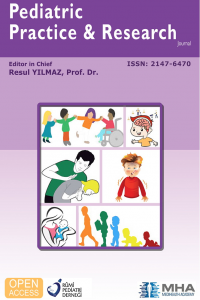Çocuklarda Staphylococcus aureus Enfeksiyonlarının Değerlendirilmesi
Çocuk, invaziv enfeksiyonlar, Staphylococcus aureus, deri ve yumuşak doku enfeksiyonları
Evaluation of Staphylococcus aureus Infections in Children
___
- 1.Centers for Disease Control and Prevention (CDC). Outbreaks of community-associated methicillin-resistant Staphylococcus aureus skin infection-Los Angeles County, California, 2002-2003. MMWR Morb Mortal Wkly Rep. 2003;52(5):88.
- 2.Boucher HW, Corey GR. Epidemiology of methicillin-resistant Staphylococcus aureus. Clin Infect Dis. 2008;46 Suppl 5: S344-9.
- 3. Tong SY, Davis JS, Eichenberger E, Holland TL, Fowler VG. Staphylococcus aureus infections: epidemiology, pathophysiology, clinical manifestations, and management. Clin Microbiol Rev. 2015;28(3):603-61.
- 4. DeLeo FR, Diep BA, Otto M. Host defense and pathogenesis in Staphylococcus aureus infections. Infect Dis Clin North Am. 2009;23(1):17-34.
- 5. Foster TJ. Immune evasion by staphylococci. Nat Rev Microbiol. 2005;3(12):948-58.
- 6. Shallcross LJ, Fragaszy E, Johnson AM, Hayward AC. The role of the Panton Valentine leucocidin toxin in staphylococcal disease: a systematic review and meta-analysis. The Lancet Infectious Diseases. 2013;13(1):43-54.
- 7. Rasigade JP, Vandenesch F. Staphylococcus aureus: a pathogen with still unresolved issues. Infect Genet Evol. 2014; 21:510-4.
- 8.Klevens RM, Morrison MA, Nadle J, et al. Invasive methicillin-resistant Staphylococcus aureus infections in the United States. JAMA 2007; 298:1763.
- 9. Charlebois, E.D., Perdreau-Remington, F., Kreiswirth, B., et al. Origins of community strains of methicillin-resistant Staphylococcus aureus. Clin Infect Dis. 2004;39(1):47- 54.
- 10. David MZ, Daum RS. Community-associated methicillin-resistant Staphylococcus aureus: epidemiology and clinical consequences of an emerging epidemic. Clinical microbiology reviews. 2010;23(3):616-87.
- 11. DeLeo FR, Otto M, Kreiswirth BN, Chambers HF. Community-associated methicillin resistant Staphylococcus aureus. The Lancet. 2010;375(9725):1557-68.
- 12. Miller LG, Perdreau-Remington F, Bayer AS, et al. Clinical, and epidemiologic characteristics cannot distinguish community-associated methicillin-resistant Staphylococcus aureus infection from methicillin-susceptible S. aureus infection: a prospective investigation. Clin Infect Dis. 2007; 44:471.
- 13.Gomes RT, Lyra TG, Alves NN, Caldas RM, Barberino MG, Nascimento-Carvalho CM. Methicillin-resistant and methicillin-susceptible community-acquired Staphylococcus aureus infection among children. Braz J Infect Dis. 2013;17(5):573-578.
- 14.Al Kindi A, Alkahtani AM, Nalubega M, et al. Staphylococcus aureus Internalized by Skin Keratinocytes Evade Antibiotic Killing. Front Microbiol. 2019; 10:2242.
- 15. Gottlieb M, DeMott JM, Hallock M, Peksa GD. Systemic Antibiotics for the Treatment of Skin and Soft Tissue Abscesses: A Systematic Review and Meta-Analysis. Ann Emerg Med 2019; 73:8.
- 16. Howard-Jones AR, Al Abdali K, Britton PN. Acute bacterial lymphadenitis in children: a retrospective, cross-sectional study. Eur J Pediatr. 2023;182(5):2325-33.
- 17. Wen Y, Wang C, Jia H, Liu T, Yu J, Zhang M. Comparison of diagnosis and treatment of MSSA and MRSA osteomyelitis in children: a case-control study of 64 patients. J Orthop Surg Res. 2023;18(1):197.
- 18. Messina AF, Namtu K, Guild M, Dumois JA, Berman DM. Trimethoprim-sulfamethoxazole therapy for children with acute osteomyelitis. Pediatr Infect Dis J. 2011;30(12):1019-21.
- 19. Arnold SR, Elias D, Buckingham SC, et al. Changing patterns of acute hematogenous osteomyelitis and septic arthritis: emergence of community-associated methicillin resistant Staphylococcus aureus. J Pediatr Orthop 2006; 26:703.
- 20. Cea-Pereiro JC, Garcia-Meijide J, Mera-Varela A, Gomez-Reino JJ. A comparison between septic bursitis caused by Staphylococcus aureus and those caused by other organisms. Clin Rheumatol. 2001;20(1):10-14.
- 21. Aguilera-Alonso D, Kirchschläger Nieto S, Ara Montojo MF, et al. Staphylococcus aureus Community-acquired Pneumonia in Children After 13-Valent Pneumococcal Vaccination (2008-2018): Epidemiology, Clinical Characteristics and Outcomes. Pediatr Infect Dis J. 2022;41(5): e235-e242.
- 22. American Academy of Pediatrics. Staphylococcus aureus. In: Red Book: 2021-2024 Report of the Committee on Infectious Diseases, 32 ed, Kimberlin DW, Barnett ED, Lynfield R, Sawyer MH (Eds), American Academy of Pediatrics, Itasca, IL 2021. p.678.
- 23. Suryati BA, Watson M. Staphylococcus aureus bacteraemia in children: a 5-year retrospective review. J Paediatr Child Health 2002; 38:290.
- 24. McNeil JC, Ligon JA, Hulten KG, et al. Staphylococcus aureus Infections in Children With Congenital Heart Disease. J Pediatric Infect Dis Soc 2013; 2:337.
- 25. Vallejo JG, Cain AN, Mason EO, Kaplan SL, Hultén KG. Staphylococcus aureus Central Nervous System Infections in Children. Pediatr Infect Dis J. 2017;36(10):947-951.
- 26. Ligon J, Kaplan SL, Hulten KG, et al. Staphylococcus aureus bacteremia without a localizing source in pediatric patients. Pediatr Infect Dis J 2014; 33: e132. 14.
- 27. Hamdy RF, Dona D, Jacobs MB, Gerber JS. Risk Factors for Complications in Children with Staphylococcus aureus Bacteremia. J Pediatr 2019; 208:214.
- 28. Paintsil E. Pediatric community-acquired methicillin-resistant Staphylococcus aureus infection and colonization: trends and management. Curr Opin Pediatr 2007; 19:75.
- 29. Şanlı K. Susceptibility Patterns of Community-acquired and Hospital-acquired Staphylococcus aureus Strains Against Various Antimicrobials. İKSSTD 2020;12(2):188-93
- ISSN: 2147-6470
- Başlangıç: 2013
- Yayıncı: MediHealth Academy Yayıncılık
Over Torsiyon Detorsiyon Kaynaklı Over ve Akciğer Hasarına Karşı Rosmarinik Asidin Etkisi
Ayhan TANYELİ, Fazile Nur EKİNCİ AKDEMİR, Derya GÜZEL, Kardelen ERDOĞAN, Ersen ERASLAN, Gökhan BİLGİN, Mustafa Can GÜLER
COVID-19 Tanılı Çocuklarda ABO-Rh Kan Grupları ile Hastalık Şiddeti Arasındaki İlişki
Edanur YEŞİL, Ali ÖZDEMİR, Meltem ERDEM, Berfin ÖZGÖKÇE ÖZMEN, Mehtap AKÇA, Beyhan BÜLBÜL, Burcu BURSAL DURAMAZ, Güldane DİKME, Aslınur Meryem KARAGÜVEN, Hakan YAZAN, Velat ŞEN, Kamil YILMAZ, Erkan ÇAKIR, Ozden TUREL, Solmaz ÇELEBİ, Mustafa Kemal HACIMUSTAFAOĞLU, Necdet KUYUCU
Psikiyatri Araştırma Alanında Pandas Sendromu ile İlgili Yayınların Bibliyometrik Analizi
Farklı bakteriyel kontaminasyonun sıçanlarda deneysel adeziv barsak obstrüksiyonuna etkisi
Gökhan DEMİRTAŞ, Doğuş ÇALIŞKAN, Pınar CELEPLİ, Sema HÜCÜMENOĞLU, Tuğrul TİRYAKİ
Curry Jones Sendromlu Hastada Preoperatif Anestezi Yönetimi
Burcu GEZER YURTERİ, Mehmet SARGIN
Çocuklarda Staphylococcus aureus Enfeksiyonlarının Değerlendirilmesi
Gülsüm ALKAN, Hatice TÜRK DAĞI, Melike EMİROĞLU, Rumeysa İPTEŞ, Şadiye Kübra TÜTER ÖZ, Meltem KIYMAZ, Muslu Kazım KÖREZ
Fatma SARGIN, Sinan DEĞİRMENCİOĞLU, Ali SEVGİLİ, Jale Bengi ÇELİK
